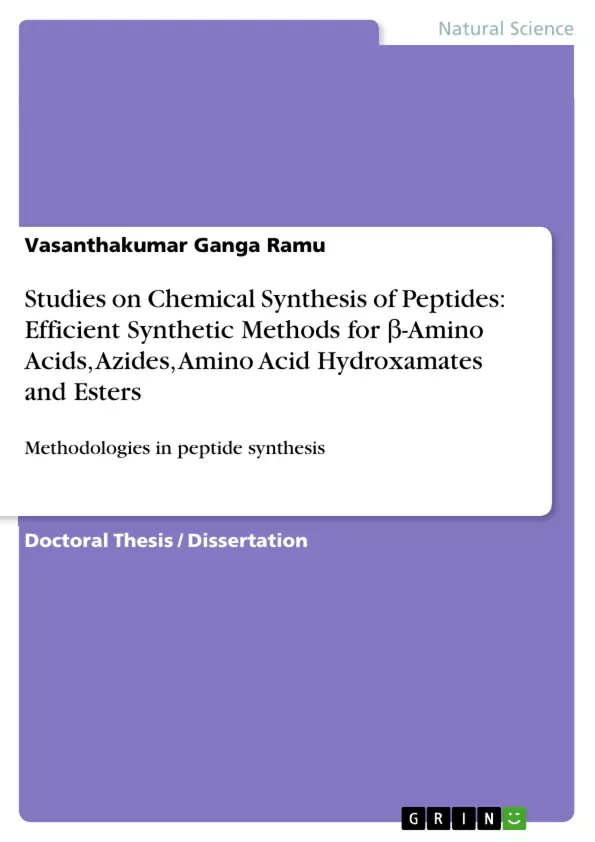The importance of ß-amino acids has been focused, particularly in the past few decades. They are found as components of many biologically active peptidic and nonpeptidic natural products with antibiotic, antifungal, cytotoxic, and other pharmacological properties. ß-Amino acids are produced in humans, animals, microorganisms, marine organisms, and plants either in free state or as part of a peptide or depsipeptide. The importance of nonpeptidic ß-amino acids has been nfocused particularly on the ß-lactam antibiotics, since naturally occurring penicillin derivatives have been discovered as broad antibiotic active agents. Over the years, a large number of these compounds have been prepared and tested, and a variety of new ß-lactam ring systems have been introduced such as cephems, cephalosporins, oxacephems, penems, carbapenems, oxapenams as well as monocyclic and polycyclic ring systems. ß-Amino acids have been known to play an important role in primary and secondary metabolism also. [...]
Inhaltsverzeichnis (Table of Contents)
- Introduction
- Peptides
- B-Amino Acids
- Azides
- Amino Acid Hydroxamates and Esters
- Results and Discussion
- Synthesis of B-Amino Acids
- Synthesis of Azides
- Synthesis of Amino Acid Hydroxamates
- Synthesis of Amino Acid Esters
- Experimental
- General Procedures
- Chemicals and Solvents
- Chromatographic Techniques
- Spectroscopic Techniques
Zielsetzung und Themenschwerpunkte (Objectives and Key Themes)
This thesis explores the synthesis of B-amino acids, azides, amino acid hydroxamates, and esters. The primary objective is to develop efficient and convenient methods for the preparation of these compounds, which are important building blocks in the synthesis of peptides and other biologically active molecules. The thesis also investigates the applications of these synthetic methods in the development of new peptide-based drugs.
- Efficient methods for the synthesis of B-amino acids.
- Development of new synthetic strategies for the preparation of azides.
- Exploration of synthetic routes to amino acid hydroxamates.
- Investigation of methods for the synthesis of amino acid esters.
- Application of these synthetic methods to the preparation of peptides and other bioactive molecules.
Zusammenfassung der Kapitel (Chapter Summaries)
- Introduction: This chapter provides a comprehensive overview of peptides, B-amino acids, azides, amino acid hydroxamates, and esters, highlighting their importance in chemistry, biology, and medicine.
- Results and Discussion: This chapter presents the experimental results and discussions of the various synthetic methods developed for the preparation of B-amino acids, azides, amino acid hydroxamates, and esters. It explores the advantages and limitations of each method and provides insights into the reaction mechanisms involved.
- Experimental: This chapter details the experimental procedures used in the synthesis and characterization of the target compounds. It includes information on the chemicals used, solvents employed, chromatographic techniques applied, and spectroscopic methods utilized for the analysis of the products.
Schlüsselwörter (Keywords)
The primary focus of this thesis is on the synthesis of peptides, B-amino acids, azides, amino acid hydroxamates, and esters using efficient and practical methods. Key aspects of the research include the development of new synthetic routes, exploration of reaction mechanisms, and applications of these methods in the preparation of bioactive molecules. The thesis explores various aspects of peptide chemistry, including the use of protecting groups, coupling reactions, and the characterization of synthesized peptides.
- Arbeit zitieren
- Vasanthakumar Ganga Ramu (Autor:in), 2004, Studies on Chemical Synthesis of Peptides: Efficient Synthetic Methods for β-Amino Acids, Azides, Amino Acid Hydroxamates and Esters, München, GRIN Verlag, https://www.grin.com/document/179845



